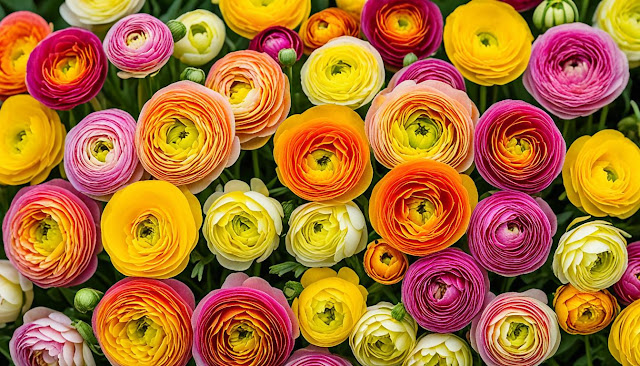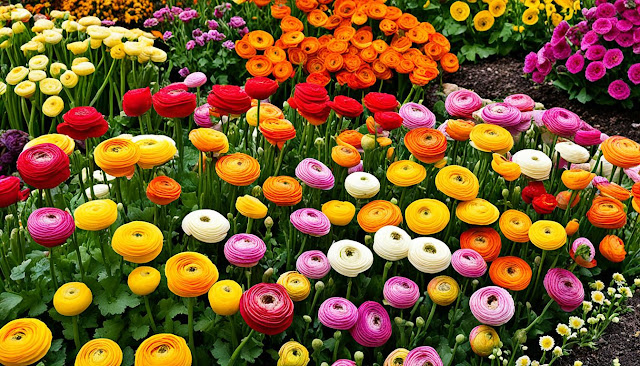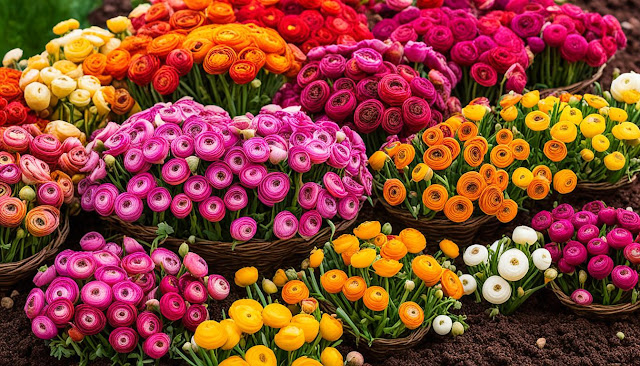 |
| ranunculus corms |
Have you ever dreamt of a magical garden full of vibrant blooms? Ranunculus corms are the secret. They turn your ordinary garden into a fairy tale paradise.
Ranunculus corms are small but mighty. They unlock a world of beauty in your garden. But what are they really? And how can you grow them for a stunning garden? Let's explore the secrets that will set your garden apart.
- Ranunculus corms are the secret to a garden filled with vibrant blooms.
- Understanding how to grow and care for ranunculus corms is key to their success.
- Ranunculus flowers are unmatched in their beauty and make a popular choice among gardeners.
- With the right techniques and care, you can enjoy stunning ranunculus blooms year after year.
- Get ready to unleash the beauty of ranunculus corms and create a flourishing garden.
What Makes Ranunculus Corms a Popular Choice for Gardens?
Ranunculus flowers are known for their bright colors and soft petals. They catch the eye of many garden lovers. People love them for the beauty and charm they bring to gardens.
Ranunculus flowers come in many colors and shapes. You can find them as single petals or doubled up. This variety helps make any garden or bouquet look amazing.
Ranunculus stands out as a flower for cutting because of its looks and how long it lasts. With their many layers and fine details, they remind some of top flowers like roses. They add a classy touch to any bunch of flowers.
Ranunculus corms are special because they make more of themselves. Unlike bulbs, they create more corms each year. This makes your ranunculus garden grow bigger and better over time.
Also, growing ranunculus is a smart way to save money in your garden. They are easy to spread and multiply. So, you can grow your garden without spending on new plants.
Ranunculus corms do well in many different climates. They don't need as much specific care as bulbs do. This means more people can enjoy their beautiful flowers.
To grow ranunculus well, remember they like cooler weather. They do best when it's around 55 to 60 degrees Fahrenheit. Use soil that drains well but stays a bit moist, not wet.
How to Plant Ranunculus Corms for Best Results
 |
| Ranunculus Corms |
Getting ranunculus corms planted right is key for strong growth and blooms. You'll get great advice on how to soak the corms ahead of planting. Plus, you'll learn the best times to plant based on where you live and some planting tricks for different climate zones.
Pre-soaking ranunculus corms: The first step to success
Before you set your ranunculus corms, consider pre-soaking them. This step helps them get hydrated and start to sprout, setting them up for success. Just soak them in water at room temperature for a few hours. It makes the corms' outer layer soft, which helps roots grow quickly after planting.
Deciding the right time to plant ranunculus corms
When to plant your ranunculus corms depends on the bloom time you want and where you live. If you have cold winters, plant in the fall. This gives them time to grow strong roots before winter. Then, they'll be all set to bloom in the spring. For warmer places, plant in the early spring. You'll see their flowers in late spring or early summer.
Planting tips for ranunculus in different climate zones
Ranunculus does well in various climates with the right care. Here's what to do for each area:
| Climate Zone | Planting Method |
|---|---|
| Zones 8-10 (mild winters) |
|
| Colder Zones |
|
Use these tips and match your actions with your climate to help your ranunculus thrive. Don't forget to take good care of them as they grow. With proper care, your ranunculus will reward you with stunning flowers.
The Art of Growing Ranunculus: From Corm to Bloom
 |
| nurturing ranunculus flowers |
Creating the ideal environment for ranunculus to thrive
For ranunculus to grow well, the right setup is key. They like soil that drains well but keeps some moisture. Space them apart for air to move freely around them. This prevents diseases and rot. Adding a layer of mulch helps keep the soil cozy and even-tempered.
Maintaining moisture but avoiding soggy conditions
Good moisture is important for ranunculus, but too much can be bad. It causes their roots to rot. Water them regularly but not too often. Also, make sure the soil is not too wet. Mulch and well-draining soil keep the moisture just right.
The role of sunlight in nurturing ranunculus flowers
Sun is crucial for the best ranunculus blooms. They need a lot of direct sun, ideally 6-8 hours daily. Without enough sun, they might not grow well or flower much.
| Requirements | Ideal Conditions | Optimal Results |
|---|---|---|
| Soil | Well-draining soil | Prevents waterlogging and root rot. |
| Moisture | Moderate soil moisture | Healthy growth without soggy conditions. |
| Sunlight | Full sun or 6-8 hours of direct sunlight | Abundant blooms and strong growth. |
Common Issues and Solutions When Growing Ranunculus Corms
 |
| Preventing and addressing rot in ranunculus corms |
Growing ranunculus corms is rewarding but it has its challenges. Here are tips to have a successful ranunculus garden. These will help ensure you have beautiful blooms all season long.
Preventing and Addressing Rot in Ranunculus Corms
Rot is a common issue with ranunculus corms. Good drainage is key to prevent it. Make sure the soil drains well and isn't too wet. Don't water your ranunculus too much. Let the soil dry a bit between waterings. If you do see rot, remove the affected corms fast. Use fungicides to help the healthy ones stay free of rot.
How to Protect Ranunculus from Colder Climates
Ranunculus plants don't like the cold. If you live where it gets cold, protect your plants. Plant them in containers or in beds you can move inside when it's frosty. You can also use frost blankets or tunnels to keep them warm. These steps will help your ranunculus plants survive the cold.
Ensuring Continuous Blooms in Your Ranunculus Garden
To have blooms all season, plant your corms at different times. This makes the flowers last longer. It keeps your garden colorful too. Always remove the spent flowers. This tells the plant to make more blooms. Feed your plants with balanced fertilizer for extra flowering power.
| Common Issues | Solutions |
|---|---|
| Rot in ranunculus corms | Ensure proper drainage and avoid overwatering. Remove affected corms and use fungicides. |
| Protection from colder climates | Plant in containers or protected garden beds. Use frost blankets or low tunnels for insulation. |
| Continuous blooms | Implement staggered planting. Deadhead spent flowers and provide regular fertilization. |
Harvesting and Storing Ranunculus Corms for Next Season
 |
| harvesting ranunculus corms |
When and how to harvest ranunculus corms
It's key to pick ranunculus corms at just the right moment. Wait until the leaves turn yellow and wilt. This means the corms have stored the plant's energy and are ready for digging up.
When you dig them up, do it gently. Be careful not to hurt the corms. After digging, shake off any extra dirt.
Storing ranunculus corms correctly: Dry place and cool temperatures
For good future growth, store the corms right. Let the corms dry fully after harvesting. A cool, dry spot is perfect for drying. Avoid sun and very damp places.
Keep the corms in a spot that's between 45°F and 55°F. This way, they stay healthy and save energy for the next season.
Preparing your ranunculus corms for the next planting season
Before planting corms next season, check them for problems. Throw away any with rot or disease to keep the others safe.
You might need to use special products to keep the corms healthy. This is a good step to take.
Soaking the corms in water for some hours is helpful. This makes them swell up and gets them ready to grow well next season.
Joining a Ranunculus Gardeners Newsletter for Tips and Guidance
 |
| ranunculus gardeners newsletter |
For those who love ranunculus flowers, a gardeners' newsletter is a must. It's full of great tips and advice on how to grow and take care of these plants. With the help of experienced growers, your garden can be filled with beautiful blooms.
Sunny Meadows Flower Farm and Sierra Flower Farm are well-known for their advice. They're experts in ranunculus and share their exclusive tips in their newsletters. Subscribing means you're on the path to gardening success with ranunculus.
But, the journey doesn't end there. There are online communities and forums full of people who love ranunculus. They share stories and offer advice. It's a perfect place to find new plant types and learn where to buy them.
Joining a newsletter can bring you closer to many experts and enthusiasts. Whether it's through advice from top flower farms or by connecting with the community, your gardening skills will improve. It's a wonderful step towards a thriving ranunculus garden.
Conclusion
Growing ranunculus corms can lead to a garden full of stunning and vibrant blooms. Gardeners who understand the needs of ranunculus plants can be successful. It's important to know how to plant, care for, and harvest them well.
Trying out various ranunculus types and garden techniques can improve your skills. You can learn from a ranunculus gardeners newsletter. This way, you'll get tips from experienced growers and experts like Sunny Meadows Flower Farm.
To grow ranunculus well, pay attention to details. Make sure they have the right environment, enough water, and plenty of sunlight. By following these steps, you can have plenty of beautiful blooms in your garden. Correctly harvesting and storing corms means they'll bloom year after year.
In the end, nurturing ranunculus corms is fulfilling. It brings beauty to your garden every year. With care and knowledge, you can experience the stunning flowers of ranunculus in your garden.
